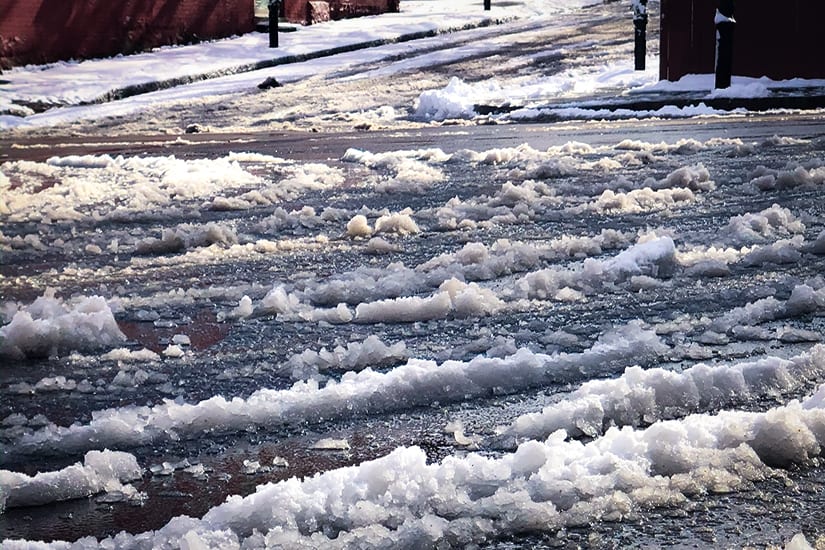With the first snow of the season expected to fall this week in Virginia, it’s important to keep these safety tips in mind while traveling.

When snow falls here in Virginia we know we can expect business closings, traffic delays, and, unfortunately, car accidents. Some of these accidents can potentially be avoided if drivers are familiar with safety tips for handling snowy and icy conditions. We’ve collected a few resources and tips that will hopefully help keep you and your loved ones safe on the roads this winter.
The first thing you should do any time a storm is headed into your area is to check your local news source for updates on road and travel conditions. You can call 511 or visit http://www.511virginia.org for current driving conditions across the Commonwealth. You can also check plow routes and schedules at the Virginia DOT plow site, to see the status of snow plows in your neighborhood. And when you do head out on the roads during a snow storm, it’s important to give plows and sanders plenty of space, and never pass them unless it’s absolutely necessary. Think of them as a type of emergency vehicle, and give them as wide a berth as you can.

In many cases, state officials will ask drivers to remain off the roads during a big snowfall, but sometimes traveling is unavoidable, even if road conditions are poor. If you must travel in wintry conditions, plan for additional time — not just because driving will be slower, but also so that you can fully clean off your car before you pull out of your driveway. It’s never safe to drive with your windows only partially cleared of snow and ice; you want to be sure that you have full visibility when you’re behind the wheel. It’s also important to clear any snow from your roof so that it doesn’t blow off of your car and onto another vehicle while you’re driving. That could be very dangerous to the other driver, and could potentially cause an accident.
Whenever you are out on the road in wintry weather, there are a few important driving tips to keep in mind. On icy roads it’s never a good idea to move the steering wheel too quickly from side-to-side or brake too quickly. Doing either of these things could cause you to lose control of your vehicle. Slow movements of the steering wheel and gentle braking will help you stay in control. Drive slowly and cautiously, leaving plenty of room between your car and any others, to lessen the chances that you’ll be in a situation where you’ll have to slam on the brakes. When the roads are slippery, you’ll need more distance and time to stop your car, and following at a distance that is safe on dry roads could easily lead to a bad accident if the roadway is covered with snow and ice.
Be cautious of all-wheel-drive vehicles; they tend to bring drivers a false sense of security. Whether you are behind the wheel of a four-wheel-drive car or someone else on the road is, be aware of the fact that just having an all-wheel drive vehicle doesn’t ensure that the car won’t slip and slide. Some people with four-wheel-drive will drive faster than is safe in bad weather, because they believe their car will keep them from slipping and sliding. A good winter vehicle will help, but driving skills are really what will keep you safe on wintry roads. If you can, signing up for a winter-driving class or going out to practice your snow-driving skills in an empty parking lot or other safe environment is a helpful thing to do.
You should also make sure you know how to use your anti-lock brakes (ABS). ABS have been required on all new cars in the US since September 2013, and they are a great safety feature that help prevent your car from skidding by keeping your wheels from locking up. ABS allow you to still steer while you brake — an on-board computer manages the amount of braking pressure on each wheel. So if you find yourself in a slippery situation where you do need to slam on the brakes, press the brake pedal down as hard as you can and don’t let up — your ABS system will go to work maximizing your braking ability and will hopefully keep your car from skidding.
If you do feel your car beginning to skid, do your best to look where you want to go, instead of where the car is heading. It can be hard to do, but if you look toward where you want your car to go you’re much more likely to actually head in that direction! Your peripheral vision can keep tabs on whatever you’re trying to avoid, while your straight-ahead vision will help you get where you need to go.
It’s also a good idea to always have emergency winter supplies in your car, in case you do ever get stuck in a snowbank. Before any storms hit, pack up a bag or box with blankets, extra hats and gloves, a working flashlight, a snow-scraper, a shovel, flares, a battery-operated weather radio, and some water and non-perishable snacks. That way if you have to wait for help to arrive, you’ll be able to stay warm and safe.
As winter gets into full-swing here in Virginia, we here at Burnett & Williams wish you safe driving!
Burnett & Williams Personal Injury Lawyers are experienced with all personal injuries. If you’ve been hurt in an accident and need representation or advice, call us for a free consultation. (703) 777-1650, or contact us here on the web.